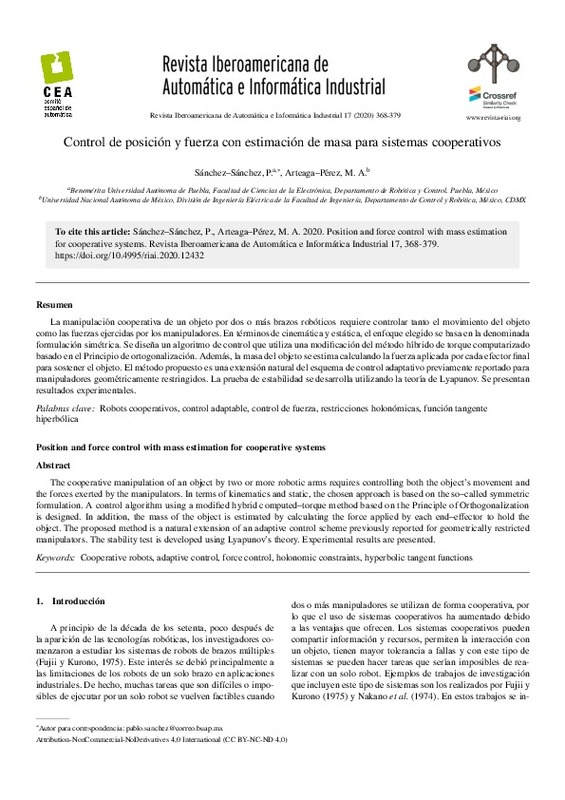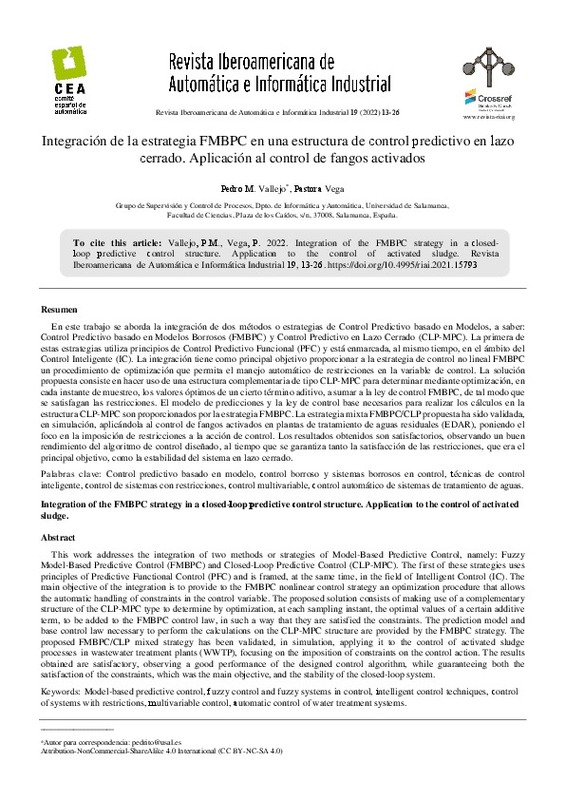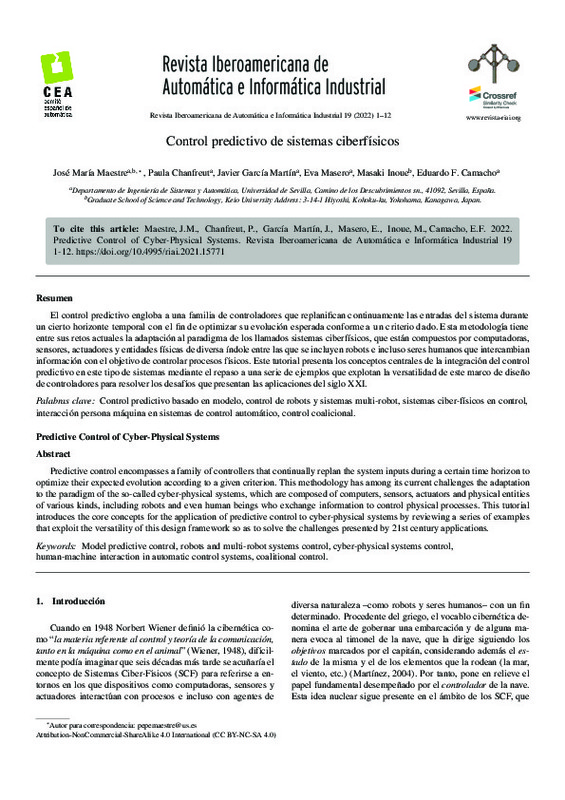JavaScript is disabled for your browser. Some features of this site may not work without it.
Buscar en RiuNet
Listar
Mi cuenta
Estadísticas
Ayuda RiuNet
Admin. UPV
Control de posición y fuerza con estimación de masa para sistemas cooperativos
Mostrar el registro sencillo del ítem
Ficheros en el ítem
| dc.contributor.author | Sánchez-Sánchez, P.
|
es_ES |
| dc.contributor.author | Arteaga-Pérez, M. A.
|
es_ES |
| dc.date.accessioned | 2020-10-05T11:53:06Z | |
| dc.date.available | 2020-10-05T11:53:06Z | |
| dc.date.issued | 2020-09-30 | |
| dc.identifier.issn | 1697-7912 | |
| dc.identifier.uri | http://hdl.handle.net/10251/151140 | |
| dc.description.abstract | [ES] La manipulación cooperativa de un objeto por dos o más brazos robóticos requiere controlar tanto el movimiento del objeto como las fuerzas ejercidas por los manipuladores. En términos de cinemática y estática, el enfoque elegido se basa en la denominada formulación simétrica. Se diseña un algoritmo de control que utiliza una modificación del método híbrido de torque computarizado basado en el Principio de Ortogonalización. Además, la masa del objeto se estima calculando la fuerza aplicada por cada efector final para sostener el objeto. El método propuesto es una extensión natural del esquema de control adaptativo previamente reportado para manipuladores geométricamente restringidos. La prueba de estabilidad se desarrolla utilizando la teoría de Lyapunov. Se presentan resultados experimentales. | es_ES |
| dc.description.abstract | [EN] The cooperative manipulation of an object by two or more robotic arms requires controlling both the object’s movement and the forces exerted by the manipulators. In terms of kinematics and static, the chosen approach is based on the so–called symmetric formulation. A control algorithm using a modified hybrid computed–torque method based on the Principle of Orthogonalization is designed. In addition, the mass of the object is estimated by calculating the force applied by each end–effector to hold the object. The proposed method is a natural extension of an adaptive control scheme previously reported for geometrically restricted manipulators. The stability test is developed using Lyapunov’s theory. Experimental results are presented. | es_ES |
| dc.description.sponsorship | Los autores agradecen a PRODEP (PROMEP) con el folio BUAP–811 y al proyecto PAPIIT IN117820. | es_ES |
| dc.language | Español | es_ES |
| dc.publisher | Universitat Politècnica de València | es_ES |
| dc.relation.ispartof | Revista Iberoamericana de Automática e Informática industrial | es_ES |
| dc.rights | Reconocimiento - No comercial - Sin obra derivada (by-nc-nd) | es_ES |
| dc.subject | Cooperative robots | es_ES |
| dc.subject | Adaptive control | es_ES |
| dc.subject | Force control | es_ES |
| dc.subject | Holonomic constraints | es_ES |
| dc.subject | Hyperbolic tangent functions | es_ES |
| dc.subject | Robots cooperativos | es_ES |
| dc.subject | Control adaptable | es_ES |
| dc.subject | Control de fuerza | es_ES |
| dc.subject | Restricciones holonómicas | es_ES |
| dc.subject | Función tangente hiperbólica | es_ES |
| dc.title | Control de posición y fuerza con estimación de masa para sistemas cooperativos | es_ES |
| dc.title.alternative | Position and force control with mass estimation for cooperative systems | es_ES |
| dc.type | Artículo | es_ES |
| dc.identifier.doi | 10.4995/riai.2020.12432 | |
| dc.relation.projectID | info:eu-repo/grantAgreement/BUAP//811/ | es_ES |
| dc.relation.projectID | info:eu-repo/grantAgreement/UNAM/PAPIIT/IN117820/MX/Control y regulación de fuerza en sistemas de teleoperación bilateral./ | es_ES |
| dc.rights.accessRights | Abierto | es_ES |
| dc.description.bibliographicCitation | Sánchez-Sánchez, P.; Arteaga-Pérez, MA. (2020). Control de posición y fuerza con estimación de masa para sistemas cooperativos. Revista Iberoamericana de Automática e Informática industrial. 17(4):368-379. https://doi.org/10.4995/riai.2020.12432 | es_ES |
| dc.description.accrualMethod | OJS | es_ES |
| dc.relation.publisherversion | https://doi.org/10.4995/riai.2020.12432 | es_ES |
| dc.description.upvformatpinicio | 368 | es_ES |
| dc.description.upvformatpfin | 379 | es_ES |
| dc.type.version | info:eu-repo/semantics/publishedVersion | es_ES |
| dc.description.volume | 17 | es_ES |
| dc.description.issue | 4 | es_ES |
| dc.identifier.eissn | 1697-7920 | |
| dc.relation.pasarela | OJS\12432 | es_ES |
| dc.contributor.funder | Benemérita Universidad Autónoma de Puebla | es_ES |
| dc.contributor.funder | Universidad Nacional Autónoma de México | es_ES |
| dc.description.references | Arimoto, S. and Liu, Y. H. and Naniwa, T., 1993. Principle of Orthogonalization for Hybrid Control of Robot Arms. Proceedings of the IFAC 12th Triennial World Congress. Volume 26, Issue 2, Part 3, 335-340. Sidney, Australia. https://doi.org/10.1016/S1474-6670(17)48744-1 | es_ES |
| dc.description.references | Arimoto, S. and Liu, Y. H. and Naniwa, T., 1993. Model-Based Adaptive Hybrid Control for Geometrically Constrained Robots. Proceedings IEEE International Conference on Robotics and Automation. 618-623. Atlanta, GA, USA. https://doi.org/10.1109/ROBOT.1993.292047 | es_ES |
| dc.description.references | Dauchez, P. and Zapata, R., 1985. Co-ordinated control of two cooperative manipulators: the use of a kinematic model. Proceedings 15th Int. Symp. Industrial Robots. 641-648. Tokyo, Japan. | es_ES |
| dc.description.references | Fujii, S. and Kurono, S., 1975. Coordinated computer control of a pair of manipulators. Proceedings 4th IFToMM World Congress, University of Newcastle upon Tyne. 411-417. England. | es_ES |
| dc.description.references | Gudiño-Lau, J. and Arteaga-Pérez, M. A., 2003. Force Control with a Velocity Observer. Proc. European Control Conference (ECC 2003). 52-55. Cambridge, UK. https://doi.org/10.23919/ECC.2003.7086506 | es_ES |
| dc.description.references | Gudiño-Lau, J. and Arteaga-Pérez, M. A. and Muñoz, L. A. and Parra-Vega, V., 2004. On the control of cooperative robots without velocity measurements. IEEE Transactions on Control Systems Technology, 12 (4) 600-608. https://doi.org/10.23919/ECC.2003.10.1109/TCST.2004.824965 | es_ES |
| dc.description.references | Hayati, S., 1986. Hybrid position/force control of multi-arm cooperating robots. Proceedings of 1986 IEEE International Conference on Robotics and Automation. 82-89. San Francisco, CA, USA. https://doi.org/10.1109/ROBOT.1986.1087650 | es_ES |
| dc.description.references | Hwang, G. and Hashimoto, H. and Szemes, P. and Ando, N., 2005. An evaluation of grasp force control in single-master multi-slave tele-micromanipulation. Proceedings of the IEEE/RSJ International Conference on Intelligent Robots and Systems. 2179-2184. Alberta, Canada. https://doi.org/10.1109/IROS.2005.1545074 | es_ES |
| dc.description.references | Kelly, R. and Santibáñez, V., 2003. Control de Movimiento de Robots Manipuladores, Pearson Prentice-Hall, Madrid, España. ISBN-10: 8420538310 / ISBN-13: 9788420538310 | es_ES |
| dc.description.references | Khalil, H. K., 1996. Nonlinear Systems (2nd Ed), Prentice-Hall, Englewood Cliffs, New Jersey ISBN-10: 9332542031 / ISBN-13: 978-9332542037 | es_ES |
| dc.description.references | Khatib, O., 1987. A Unified Approach for Motion and Force Control of Robot Manipulators: The Operational Space Formulation. IEEE Journal of Robotics and Automation, Vol. 3(1), 43-53. https://doi.org/10.1109/JRA.1987.1087068 | es_ES |
| dc.description.references | Koivo, A. J. and Bekey, G. A., 1987. Report of the Workshop on Coordinated Multiple Robot Manipulators: Planning, Control and Applications. IEEE Transactions on Robotics and Automation (IEEE Trans Robot Autom), 4(1) 91-93. ISSN: 1042-296X | es_ES |
| dc.description.references | McClamroch, N. H., 1986. Singular systems of differential equations as dynamic models for constrained robot systems. Proceedings of 1986 IEEE International Conference on Robotics and Automation, San Francisco, CA, USA 21-28. https://doi.org/10.1109/ROBOT.1986.1087712 | es_ES |
| dc.description.references | McClamroch, H. and Wang, D., 1990. Linear feedback control of position and contact force for a nonlinear constrained mechanism. ASME Journal of Dynamic Systems, Measurement, and Control, Vol. 112(4), 640-645. https://doi.org/10.1115/1.2896189 | es_ES |
| dc.description.references | Murphey, T. D. and Horowitz, M., 2008. Adaptive cooperative manipulation with intermit- tent contact. Proc. IEEE International Conference on Robotics and Automation, Pasadena, California. USA 1483-1488. https://doi.org/10.1109/ROBOT.2008.4543411 | es_ES |
| dc.description.references | Nakano, E. and Ozaki, S. and Ishida, T. and Kato, I., 1974. Cooperational control of the anthropomorphous manipulator MELARM. Proceedings 4th Int. Symp. Industrial Ro- bots, 251-260. Tokyo, Japan. | es_ES |
| dc.description.references | Naniwa, T. and Arimoto, S. and Parra-Vega, V., 1994. A model-based adaptive control scheme for coordinated control of multiple manipulators. Proceedings of the IEEE/RS- J/GI International Conference on Intelligent Robots and Systems, Munich, Germany 695-702. https://doi.org/10.1109/IROS.1994.407357 | es_ES |
| dc.description.references | Pliego-Jiménez, J. and Arteaga-Pérez, M., 2017. On the adaptive control of cooperative robots with time-variant holonomic constraints. International Journal of Adaptive Control and Signal Processing, 31(8) 1217-1231. https://doi.org/10.1002/acs.2758 | es_ES |
| dc.description.references | Rahman, S. M. M. and Ikeura, R., 2012. Weight-perception-based novel control for cooperative lifting of objects with a power assist robot by two humans. International Conference on Biomedical Robotics and Biomechatronics (BioRob), Rome, Italy 228-233. https://doi.org/10.1109/BioRob.2012.6290259 | es_ES |
| dc.description.references | Raibert, M. and Craig, J., 1981. Hybrid position/force control of manipulators. ASME Journal of Dynamic Systems, Measurement, and Control, Vol. 103(2), 126-133. https://doi.org/10.1115/1.3139652 | es_ES |
| dc.description.references | Rivera-Dueñas, J. C. and Arteaga-Pérez, M. A., 2013. Robot force control without dynamic model: Theory and experiments. Robotica, Vol. 31(1) 149-171. https://doi.org/10.1017/S026357471200015X | es_ES |
| dc.description.references | Rugthum, T. and Tao, G., 2014. An adaptive actuator failure compensation scheme for a cooperative manipulator system. Proc. American Control Conference, Portland, Oregon. USA 1951-1956. https://doi.org/10.1109/CDC.2015.7403208 | es_ES |
| dc.description.references | Sánchez-Sánchez, P. and Arteaga-Pérez, M. A., 2017. Improving force tracking control performance in cooperative robots. International Journal of Advanced Robotic Systems, 14(4) 1-15. https://doi.org/10.1177/1729881417708969 | es_ES |
| dc.description.references | Slotine, J. J. E. and Li, W., 1991. Applied Nonlinear Control. Prentice-Hall, Englewood Cliffs, New Jersey. ISBN-10: 0130408905 / ISBN-13: 978-0130408907 | es_ES |
| dc.description.references | Spong, M. W. and Hutchinson, S. and Vidyasagar, M., 2006. Robot Modeling and Control. John Wiley and Sons, USA. ISBN-10: 0471649902 / ISBN-13: 978-0471649908 | es_ES |
| dc.description.references | Tarn, T. J. and Bejczy, A. K. and Yun, X., 1988. New nonlinear control algorithms for multiple robot arms. IEEE Transactions on Aerospace and Electronic Systems, 24(5) 571-583. https://doi.org/10.1109/7.9685 | es_ES |
| dc.description.references | Uchiyama, M. and Iwasawa, N. and Hakomori, K., 1987. Hybrid position/force control for coordination of a two-arm robot. Proceedings of 1987 IEEE International Conference on Robotics and Automation, 1242-1247, Raleigh, NC, USA. https://doi.org/10.1109/ROBOT.1987.1087766 | es_ES |
| dc.description.references | Uchiyama, M. and Dauchez, P., 1988. A symmetric hybrid position/force control scheme for the coordination of two robots. Proceedings of 1988 IEEE International Conference on Robotics and Automation, 350-356, Philadelphia, PA, USA. https://doi.org/10.1109/ROBOT.1988.12073 | es_ES |
| dc.description.references | Uchiyama, M. and Dauchez, P., 1993. Symmetric kinematic formulation and non- master/slave coordinated control of two-arm robots. Journal Advanced Robotics. 7(4) 361-383. https://doi.org/10.1163/156855393X00221 | es_ES |
| dc.description.references | Yun-Hui, L. and Parra-Vega, V. and Arimoto, S., 1996. Decentralized Cooperation Control: Joint-Space Approaches for Holonomic Cooperations. Proc. IEEE International Conference on Robotics and Automation, Minneapolis, Minnesota 2420-2425. https://doi.org/10.1109/ROBOT.1996.506526 | es_ES |











